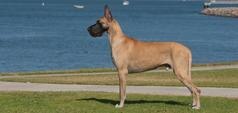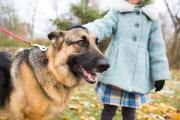
The Male Half of Dog Breeding Starts with a Healthy Stud Dog

The Importance of Evaluating the Male Dog
In cases of failed dog breeding, the male dog's role is often overlooked. However, it is advisable to prioritize investigating potential issues with the male dog, according to Margaret V. “Peggy” Root Kustritz, DVM, PhD, DACT, a board-certified canine reproduction specialist.
“There are several reasons to first evaluate the male and exclude problems with him,” says Dr. Root Kustritz, professor of small animal theriogenology and assistant dean of education at the University of Minnesota College of Veterinary Medicine.
“For one thing, males are much easier to evaluate than females, partly because their sexual anatomy is readily accessible. Also, a male breeding soundness evaluation (BSE) is relatively inexpensive. In about one hour, a knowledgeable veterinarian can work through the male half of a breeding pair.”
Conducting a Breeding Soundness Evaluation (BSE)
To ensure the fertility of stud dogs, owners should consider conducting a BSE annually, particularly after the age of 5. Puberty typically occurs between 6 to 12 months, with dogs reaching sexual maturity within three months of reaching their mature body weight. It's important to note that sexual maturity can last until age 12 or even longer.
“One might expect a decline in fertility with advancing age, and this decline may occur at an earlier age in larger breeds than in smaller breeds. However, there is great individual variation, and a breeding soundness evaluation should always be done,” says Dr. Root Kustritz.
Factors to Consider for Stud Dog Fertility
Breeders should not be misled by past reproductive success. “Past litters are not a guarantee of present fertility,” says Dr. Root Kustritz. “I’ve seen a number of ‘proven’ males suddenly become infertile. One of the ways we discover male infertility is when a bitch is bred to a particular stud a number of times with no success."
“The single greatest mistake people make regarding a male dog is to assume he is fertile. Puppies are the ultimate proof of fertility, and beyond that, a breeding soundness evaluation is the only way to know about the stud dog’s fertility.”
The Process of a BSE
During a BSE, a veterinarian starts by gathering the dog's complete medical history, including vaccination records, veterinary visits, and the dates of any illnesses or injuries. A comprehensive sexual history and a thorough physical examination are also crucial components of the examination process.
“A dog’s sexual history should include information about his sexual behavior, results of a brucellosis test, which can cause infertility in dogs, and past sperm evaluations,” says Dr. Root Kustritz. “The number of females a dog has successfully bred, the frequency of ejaculation and the dates of previous brucellosis tests are helpful. A thorough physical examination helps to determine overall health and how it may affect breeding performance. In addition, semen is collected for evaluation.”
Understanding Ejaculate Fractions and Semen Analysis
A dog’s ejaculate comes in three distinct fractions:
- The first fraction, which is usually clear and virtually sperm free, is released before full erection.
- The second fraction, the richest in sperm, comes during thrusting.
- The third fraction, which is clear with some sperm present, is ejaculated while the dogs are tied, or joined.
“Sometimes a well-meaning breeder will collect the first part of the ejaculate that is released during the thrusting and examine it,” Dr. Root Kustritz says. “There isn’t much, if any, sperm in that fraction, so the dog may mistakenly be determined sterile. The third fraction is prostatic fluid. If it contains blood, especially in older dogs, that may indicate a prostate problem.”
Once semen is collected, a laboratory analysis provides information on color, volume, debris, bacteria, and sperm motility, count and morphology. On some occasions, a semen chemistry is ordered to ensure that the ejaculate was complete or that obstructions near the testicles are not present.
For an ideal semen sample from a stud dog, approximately 80 percent of the sperm should have normal shape and exhibit active movement. However, it's important to note that temporary decreases in sperm counts can occur, particularly when a dog is exposed to extreme heat for a number of days.
“We have seen a temporarily decreased sperm count some 70 days after a long bout of hot weather,” Dr. Root Kustritz says. “It takes that long for sperm cells to mature, so dogs exposed to extreme heat may become temporarily less fertile 70 days later.”
Considering Alternatives for Stud Dogs
As for treating male reproductive disorders, Dr. Root Kustritz says owners may want to reconsider a dog’s purpose. “In many instances of reproductive disorders with stud dogs, one may want to take that dog out of service and enjoy an otherwise healthy male,” she says. “If you want to own a stud dog, it may be best to consider looking for another dog.”
Stud Dog Tips
- Male dogs can be bred between the ages of 1 and 12, with increased proficiency through more frequent breeding.
- Responsible breeding involves supervising mating to prevent injury to either dog.
- Ensure that both the female and male dogs are tested for brucellosis and genetically inherited or sexually transmitted diseases.
- Use a seasoned bitch when breaking in a stud dog. She will be more cooperative and less likely to growl or snap at him than a female being bred for the first time.
- Consistency in breeding location helps the dog associate it with the process, and choosing a quiet place without other dogs reduces distractions.
- Proper conditioning is key to raising a healthy stud dog. Feeding a complete and balanced food such as Purina Pro Plan that provides optimum nutrition for health and vitality is important as well.
Purina® Pro Plan® is the #1 brand most fed and recommended brand by dog breeders in Canada.* Learn more about the what the Pro Club Breeder program has to offer, including up to 25% savings on Pro Plan dog and puppy food, a free bag of puppy food for your new pet owners and more!
*Canadian Dog Fancier survey results, November 2023
Related articles


